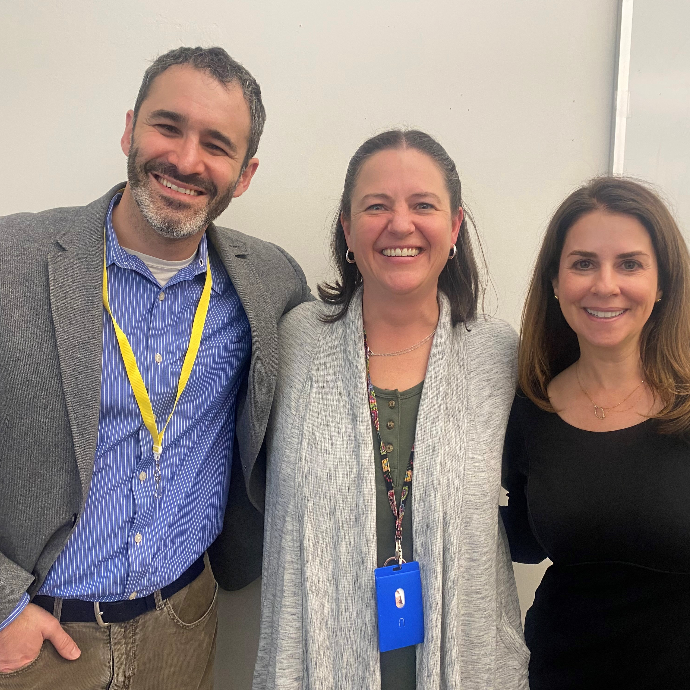Data-driven success
How strategic implementation and collaboration boosted math proficiency in Coxsackie-Athens Central School District
Shortly after the pandemic, Dr. Erica Fanning, a school psychologist at the Coxsackie-Athens Central School District (CACSD) in New York, noticed a troubling trend: their students were consistently struggling to reach proficiency in math. Despite various efforts, proficiency leveled off at 50%-60% for kindergarten through eighth grade students, according to the FastBridge aMath assessments. Fanning recognized that to improve, a systemic instructional approach was needed rather than focusing on individual interventions. She found SpringMath.
While there were some challenges getting SpringMath off the ground, the results have been remarkable. These outcomes highlight the transformative power of a well-designed instructional program and its ability to close persistent skills gaps when properly implemented.

"However, as we saw visible student growth and skill mastery, there was no denying the value. SpringMath demonstrated that our kids can do the work."
Using data to overcome skepticism and inconsistency
In spring of 2022, Fanning helped three teachers pilot SpringMath in their classrooms. Progress was reported to an MTSS team, including school psychologists, interventionists, teachers, and administrators. Significant student gains in math fluency during the pilot phase led leaders to adopt SpringMath in kindergarten through sixth grade classrooms in the 2022-2023 and 2023-2024 school years.
Initially, many teachers saw SpringMath as one more thing to fit into an already busy schedule. “There was a prevailing mindset that students were being over-assessed, and some educators did not fully appreciate the value of immediate diagnostic information for informing instruction,” shared Randy Squier, CACSD superintendent of schools. “However, as we saw visible student growth and skill mastery, there was no denying the value. SpringMath demonstrated that our kids can do the work.”
Since implementing SpringMath, data show significant growth in CACSD student math proficiency — with recent data showing that 90% of kindergarten students now demonstrate mastery or perform above the instructional level. According to Fanning, in fall 2023, only 10% of kindergarteners met all benchmarks, while 35% did not meet any; by spring, 70% met all benchmarks and less than 4% failed to meet any.

New York State Education Department data also reflect this growth. From 2022 to 2023, proficiency rates increased across multiple grades:
-
4th grade proficiency jumped from 27% to 39%
-
5th grade proficiency increased from 23% to 29%
-
6th grade proficiency rose from 25% to 31%
With greater consistency, more gains are expected. “I don't think teachers really believed that such a simple intervention would be meaningful. They felt their time had to be spent getting the kids to do the grade-level material and not closing skill gaps,” Fanning shared. Some teachers — well intended but errantly — changed the program to fit their classrooms by reducing the optimal dosage, skipping error correction, and allowing students extra time to complete assessments. Dr. Fanning added that, “Some teachers just weren’t doing it, or they would do it once a week instead of every day.”
However, even infrequent practice led to growth. First graders, practicing once or twice a week, saw improvement from 45% of students unable to meet benchmarks in fall to only 6% in spring. Sharing those results has been instrumental in gaining approval and increasing the fidelity of the program among teachers. “Finding patterns and proving that these data support what the system says gives us a lot of oomph behind it,” Fanning noted. She added that the implementation process has become easier after showing clear benefits, but fidelity is key to optimal growth, as is the case for all intervention tools or programs.
To achieve greater consistency going forward, district leaders aim to help teachers understand the “why” behind student success with SpringMath. “We’re not a culture used to doing things with fidelity or really thinking about the data,” Fanning said. “But it’s still working. It’s one of those things you have to do before you believe, and the more people do it, the more growth they see, the more excited they get.” She also emphasized that even if teachers don't fully understand the process at first, it's important to support them with regular explanations of the MTSS framework and the instructional hierarchy, which is one of the foundational theories driving SpringMath, so they can.
Dr. Freya Mercer, Coxsackie-Athens Middle School principal, echoed this sentiment, noting that sometimes the simplicity of SpringMath makes it hard to believe in its efficacy, but its straightforward approach is precisely what makes it effective in changing conversations with students about their progress and goals. “The kids are really positive about the skills they are building,” Mercer said. “It builds confidence in math for special ed students and general ed students. They want to show me what they can do, they are proud to tell me when they move on to a new skill.”
Though SpringMath appears simple, it is a research-based program with a sophisticated design. The program generates technically equivalent assessments for 145 essential skills, includes over 550 intervention protocols, and integrates novel and proprietary implementation and dosage metrics. SpringMath’s extensive decision-making processes determine the next steps or interventions based on a student’s data, ensuring students get what they need exactly when they need it. Blending complex intervention science with intuitive, simple forward-facing design makes SpringMath both powerful and easy to use.
Driving success with leadership and teamwork
Successful implementation of SpringMath required substantial support from district leaders, making resources and assistance available. “SpringMath would not work without administrator buy-in,” shared Mercer. “The administrator has to be willing to schedule it, to give teachers the time, and to provide staff." Key initiatives included shifting personnel to create two math coach positions who showed teachers how to use the system, prepared materials, helped with interventions, and collected data.
“Math coaches really made it possible for SpringMath to roll out successfully,” shared Squier. “They were instrumental in supporting teachers and having Erica has also been invaluable.” As trusted teachers in the district, the coaches served as the primary change agents, including scheduling resources, analyzing data, and providing dosage direction. Fanning played a supportive role, particularly in the second year, assisting the coaches as needed. "It really helped that the coaches were teachers themselves — teachers prefer to learn from teachers, as there's a level of trust and understanding that comes from having walked in their shoes," Fanning added.
Mercer explained that dedicated time for teachers to discuss SpringMath data and refine their instructional approaches has also been important. “We have dedicated professional learning time every morning where grade levels get together. At first, we used that time for level-setting, meeting with the math coach, and making sure everyone was on the same page. Now, we talk about how quickly kids are progressing or if anybody is falling behind that would benefit from an extra lesson or an extra practice buddy, that kind of thing.”
These evolving SpringMath conversations have created a more dynamic team process, facilitating more effective instruction and leading to better student outcomes. Instead of simply reviewing performance metrics, teachers are now actively discussing individual student progress, identifying specific needs, and implementing targeted interventions.

Leveraging higher-ed collaboration
|
As a rural, low-socioeconomic status district, CACSD has benefited significantly from its partnership with Ben Solomon, an associate professor in the Department of Educational and Counseling Psychology at the State University of New York at Albany (UAlbany), and his graduate students. Through this partnership, graduate students have the opportunity to observe MTSS and RTI in action, review data, conduct research, and provide valuable implementation support and impartial data analysis to the district. “Ben is the person who is asking prodding questions from a coaching perspective,” Squier shared, noting that Solomon eased teachers’ worries about not having enough time and extra paperwork by offering his graduate students as resources. Initially, graduate students supported classwide interventions, but quickly shifted to focusing on Tier 2 inventions as teachers became more comfortable with the program. Graduate students also gained valuable experience learning the logic of engaging in an MTSS framework and seeing positive outcomes for students. “After seeing the data and seeing that these students improved, it made them all feel really good knowing they had a hand in getting there,” Solomon shared. “Now, they really see how important it is and how they played an important role in the program.” Working with Coxsackie-Athens students opened the graduate students' eyes to the realities of school psychology. “Sometimes there’s this stereotype that they’re going to come in and sit in their office and evaluate students, and maybe do some counseling,” Solomon explained. “Not a lot of students come into school psychology thinking they need to be an instructional expert. But when they experience this new vantage point on school psychology and education, they realize it’s here that they can really help.” |
But Solomon and his graduate students are doing more than helping students learn foundational math skills — they’re studying the data. By analyzing SpringMath data, they seek to determine the most efficient math intervention methods, find optimal dosages, and use statistical analysis to estimate student growth. Two UAlbany graduate students completed dissertations on SpringMath, including a study on the assessment framework of SpringMath and another that examined how the program’s effectiveness is moderated based on the consistency of student groupings. The data confirmed that classwide intervention decision rules produce efficient and accurate decisions and promote student growth and SpringMath works best as a universal math MTSS intervention with all students included. “Right now, we're looking at trials to mastery, which skills are easiest or the most difficult to master based on the SpringMath system, and what might be predictors of that at the student level and classwide level,” Solomon shared. “We’re also looking at implementation integrity, and what features of teachers led to poor or high implementation integrity. Once we get a few years’ worth of data we can answer some really neat questions.” To expand their research, Solomon and SpringMath author Dr. Amanda VanDerHeyden have submitted a grant proposal to the Office of Elementary and Secondary Education for a large scale randomized controlled trial to explore these emerging questions. Solomon uses SpringMath as a framework to deliver hands-on practical and research experiences in a meaningful MTSS, equipping his graduate students to effectively lead and deliver multi-tiered systems of support. Through real-world application, UAlbany students are poised to complete their programs with a deep understanding of the importance of instructional design and implementation in school psychology. |
"When it comes to math fluency, SpringMath helps reinforcement rates so students will persevere. As they learn, they gain more confidence. Success breeds motivation. Students start to think, ‘If I’m good at this, I’m going to try again. I’m going to do the next step. I’m going to learn. I like math."
Building a brighter future
Next year, all CACSD kindergarten through sixth grade students will participate in SpringMath. With continued administrative support, data-driven approaches, and their partnership with UAlbany, district leaders expect further growth in math proficiency as students master foundational skills earlier. Long-term, the district aims to enhance math fluency across all grade levels, reducing the need for serious remediation and allowing for more strategic Tier 2 and Tier 3 interventions.
“When it comes to math fluency, SpringMath helps reinforcement rates so students will persevere,” explained Squier. “As they learn, they gain more confidence. Success breeds motivation. Students start to think, ‘If I'm good at this, I'm going to try again. I'm going to do the next step. I'm going to learn. I like math.’”
